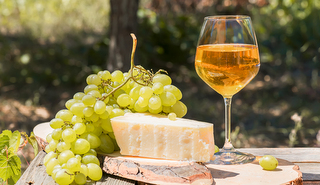Having dinner one evening in Ljubljana a while back, before our walking tour in Slovenia and Friuli, we noticed local bars selling Orange Wine and it was the first time we had seen it. Of course we had to try it and find out more about where and how it is made, but fast forward a few years to the present day and orange wine is a talking point for winemakers around the world.
There is no element of the orange fruit involved in its production; rather it is the result of white grapes being left to ferment along with their skins and seeds. The time span of this ancient method of fermentation can be anything from a few days to many months, and the result is an amber or strongly orange-hued wine.

Not only is the colour much stronger than a white wine, but the flavour is too. They are very dry, and can even have tannins like a red wine, with a certain sourness or bitterness which is unexpected if you’ve not tasted one before. With this bold flavour they pair well with stronger foods such as curries, fermented kimchi or Moroccan dishes.
The region of Goriška Brda which we hike through on our Slovenia tour has a long history of orange winemaking but north east Italy, in particular Friuli-Venezia-Giulia, is also producing a number of orange wines. Here the indigenous white grapes of the region like Friulano, Ribolla Gialla and Pinot Grigio are being used in the making of orange wine, alongside their classic, highly-prized whites.
But it’s not just a European phenomenon – the US and Australia are amongst many countries with a growing interest in this natural winemaking style.
If you’re interested in this subject then a good read is Simon J Woolf’s Amber Revolution. It tells the story of this ancient wine and includes profiles of 180 of the best producers from 20 countries around the world, along with tips for how to buy, enjoy, food-match and age orange wines.
